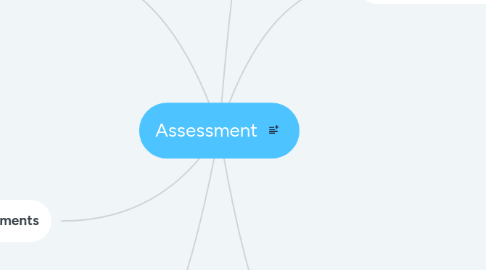
1. Considerations in Assessments
1.1. Equity
1.1.1. Lucey et al. (2020), "equity in assessment is present when all students have fair and impartial opportunity to learn and be evaluated" (p. 599).
1.1.2. Not making assumptions about a student's background knowledge
1.2. Fairness
1.3. Reliability
1.3.1. test specfic attribute
1.3.2. Consistency of what an assessment is trying to measure
1.4. validity
1.4.1. accuracy of the inferences about the test
1.4.2. human judgement
2. Purpose of Assessments
2.1. Coach and nurture learning (Wormeli, 2017)
2.2. Impact learning outcomes
2.3. inform current or future instruction
2.4. Means to an end process (Popham, 2017)
2.5. Make curricular changes
3. Strategies of Assessments
3.1. Varied (Wormeli, 2017)
3.2. Authentic
3.3. Student choice
3.3.1. UDL
3.3.2. Flexibility in demonstrating outcomes
3.4. Created with the goals in mind
3.4.1. UbD
3.4.2. UDL
3.5. Reveal the student's story (Wormeli, 2017)
4. Types of Assessments
4.1. Formative
4.1.1. quick writes
4.1.2. Entry/Exit tickets
4.1.3. Kahoot
4.1.4. In class participation
4.2. Summative
4.2.1. Final exams
4.2.2. End of chapter projects
4.2.3. High stakes exams
4.2.3.1. SAT Exams
4.2.3.2. SBAC
5. Categories of Assessments
5.1. Comparison Among Test-Takers(Popham, 2017)
5.2. Improvement of Ongoing Instruction and Learning (Popham, 2017)
5.3. Evaluation of Instruction (Popham, 2017)
5.4. Student assessment of their learning (Stiggins & Chappuis, 2005)
6. Curriculum Design & Assessment
6.1. Differentiated
6.1.1. Define the essential questions and outcomes
6.1.2. Identify unique student needs
6.1.3. Design formative and summative assessments
6.2. Wormeli (2017) Key principles
6.2.1. transparency
6.2.2. "high-quality assessment is never saved for the end of the unit" (p. 84)
6.2.3. "helpful assessment criteria are never kept a secret" (p. 85)
6.2.3.1. Rubrics
6.2.3.2. Practice exams
6.3. Consider Glatthorn's steps for curriculum evaluation
6.3.1. 1. Determine the outcomes of a program.
6.3.2. 2. Help in deciding whether to accept or reject a program.
6.3.3. 3. Ascertain the need for the revision of the course content.
6.3.4. 4. Help in future development of the curriculum material for continuous improvement.
6.3.5. 5. Improve methods of teaching and instructional techniques. (Farooq, 2014, n.p.)
